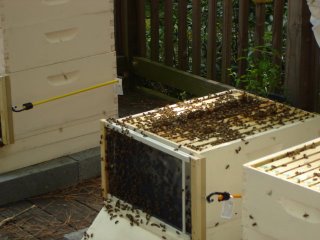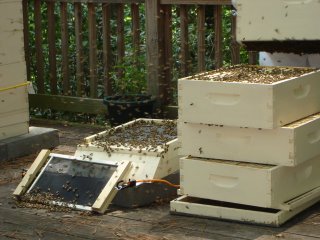Julia and I have conducted the second inspection at Blue Heron. It happened on Saturday April 23. We arrived to find that the city work trucks were occupying the space where we usually park so everyone at the inspection helped carry stuff from the BH parking lot to the community garden area.
We have three hives at the Blue Heron. Julia has an active hive, installed from a package we picked up from Don in Lula, Georgia. My hive over wintered and I split it on April 8. At that time there was no queen in the hive - the hive appeared to have swarmed. This is only 15 days after the split and each half of the split got a frame with several queen cells on it.
We didn't see signs of a laying queen in either side of the split - probably she is still in the mating phase. We did see the opened queen cell in one hive and the bees were extremely calm in the other half of the split, so we thought the queen existed but wasn't working yet.
Julia took lots of pictures, so you can see what we did. In the middle of looking through the second half of the split I dropped a hive tool that fell completely through the hive, through the slatted rack to the screened bottom board. This upset the bees (duh???) and they were not happy after that. I have worried ever since that the falling hive tool killed the queen. Gosh, I hope not, but to be sure I'll take a frame of brood and eggs from a hive at home over to them in the next couple of days.
Here's the slide show:
We have three hives at the Blue Heron. Julia has an active hive, installed from a package we picked up from Don in Lula, Georgia. My hive over wintered and I split it on April 8. At that time there was no queen in the hive - the hive appeared to have swarmed. This is only 15 days after the split and each half of the split got a frame with several queen cells on it.
We didn't see signs of a laying queen in either side of the split - probably she is still in the mating phase. We did see the opened queen cell in one hive and the bees were extremely calm in the other half of the split, so we thought the queen existed but wasn't working yet.
Julia took lots of pictures, so you can see what we did. In the middle of looking through the second half of the split I dropped a hive tool that fell completely through the hive, through the slatted rack to the screened bottom board. This upset the bees (duh???) and they were not happy after that. I have worried ever since that the falling hive tool killed the queen. Gosh, I hope not, but to be sure I'll take a frame of brood and eggs from a hive at home over to them in the next couple of days.
Here's the slide show:



















